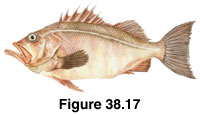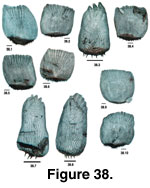 Description
Description
Sebastes paucispinis
(Bocaccio)
(Other common names: Rock Salmon, Salmon Grouper)
Figure 38.17
 Description
DescriptionLength: 91 cm.
Mouth: very large, terminal, directed forward and up; upper jaw extends to posterior margin of orbit; lower jaw projects and enters dorsal profile; symphyseal knob absent; lower jaw thickened.
Body: head spines absent except nasals and parietals, which can be present but weak; preopercular spines well developed and strong; two opercular spines strong; cleithral and supracleithral spines present but later weak; no spine on lower gill cover; caudal fin indented; profile of snout to dorsal fin is slightly concave above the eye; interorbital space convex.
Color: light brown to olive to copper; sometimes dark red on dorsal with pinkish sides; some red-orange specimens are found.
Depth: up to 250 m; young in shallow waters for first year in schools, move to deeper waters as adults.
Habitat: rocky substrate; also open bottom areas.
Season: ovoviparous; fertilization in October; young born in November; second brood born in March.
Diet: fish (e.g., surfperch; small mackerels, young sablefish, myctophids, flatfish, pelagic schooling species), molluscs, crustaceans.
Predators: not determined.
Distribution: Baja, California to Alaska.
 Scale Description
Scale DescriptionRelative Scale Size: large.
Position of Scales on Body: below lateral line canal in 72-90 rows (Hart, 1973).
Overall Shape: the scales are square, but differential elongation can make the anterior/lateral margins appear bulging. The posterior field is short.
Focus and Circuli: the focus abuts the edge of the posterior field, along the edge of ctenii growth and is approximately one-fifth to one-sixth of the total scale length from the outside edge of the posterior margin. The circuli are continuous between the lateral and anterior fields (except broken by radii).
Radii: numbers are variable and not diagnostic. Present only in the anterior field. The outer edge of the anterior field is straight (the odd scale may be slightly convex) and is scalloped.